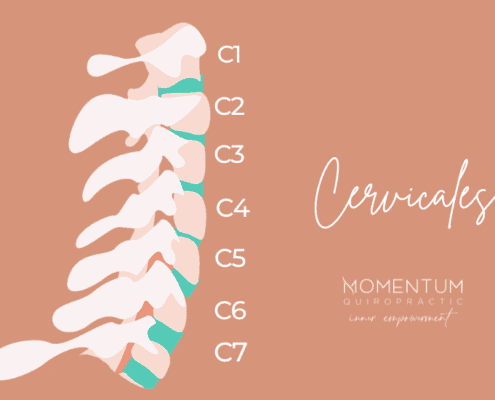Get to know the soul of your spine: thoracic vertebrae, dorsal region
And the importance of taking care of it with chiropractic
Did you know that many of the health problems related to vital organs such as the heart or lungs are related to the dorsal part of your spine?
In this second part of “Get to know the soul of your spine”, Momentum Quiropràctic team explains you about the symptoms associated with the thoracic vertebrae.
So keep reading to learn about the importance of taking care of your dorsal spine region with chiropractic and understand how to optimise your health. Ready?
But before we start, let’s take a brief look back at what we learned in the first part of this series of posts…
The spine – functions, parts and chiropractic care
As you already know, the spinal column is known as the life line due to its great importance in our health. Among its functions we find: the protection of the spinal cord and nervous system or the ability to stand upright.
In addition, we also saw the different parts of the spinal column, which is made up of 24 vertebrae (in adults) that make up 5 vertebral regions: the cervical, thoracic, lumbar, sacral and coccyx. In particular, we saw how the cervical vertebrae can be related to health problems such as migraines, insomnia, numbness in the limbs, among others.
Most importantly, we emphasised the importance of taking care of the spine and preventing pain with chiropractic.
In this post we will continue to develop our philosophy of prevention and wellness optimisation by explaining how the thoracic vertebrae are related to your health and how chiropractic can help you to heal and prevent possible ailments. Let’s get to it!
Dorsal Spine Region
Preceded by the cervical vertebrae, we find the thoracic region, which is made up of 12 vertebrae. It is therefore the longest region of the spine and runs from the base of the neck to the abdomen.
Interestingly, it is the only region of the spine attached to the rib cage, which protects vital organs such as the lungs and heart. Moreover, while the other regions of the spine are characterised by providing mobility, the thoracic region and its structure helps more to keep us stable.
The thoracic region is made up of the following vertebrae:
- T1: The T1 vertebra is the first vertebra of the thoracic spine, as well as the smallest vertebra in this region (as the vertebrae increase in size as you move down the spine to support the increased weight). This vertebra is located at the bottom of the neck and is where the first rib connects.A subluxation of this vertebra caused by different types of stress can lead to numbness in the limbs, as well as pain in the neck or upper back.
- T2:The second thoracic vertebra is related to the functions of the heart, as it is where some of the heart arteries are located. Symptoms related to T2 may include chest pain, as well as heart problems, alterations in blood pressure or heart rhythm.
- T3:The T3 vertebra controls the lungs and bronchi, as well as other muscles in the thoracic region. Therefore, this vertebra is related to possible health disorders such as breathing difficulties, asthma, cough, among others.
- T4:The fourth vertebra controls the nerves related to the gallbladder organ (located below the liver), so a subluxation in this particular vertebra can result in bile or gallbladder-related problems.
- T5, T6, T7 and T8:These four thoracic vertebrae are related to the abdominal part, so a subluxation in one of these vertebrae will usually be expressed with digestive problems (e.g. heartburn). In addition, the eighth thoracic vertebra can also present problems related to fatigue, anaemia or other circulatory problems.
Thoracic vertebrae transitional to the lumbar region:
- T9: This vertebra controls the functions of the adrenal glands – the WHAT?! Two small glands on top of each kidney that are vital for maintaining stress control (by regulating cortisol, among other functions).
- T10, T11 and T12: This last section of thoracic vertebrae is mainly related to the lower abdominal muscles, so a subluxation or misalignment of these vertebrae can lead to muscular problems (e.g. numbness or pain) in the lower muscles and limbs.
Symptoms of neck problems and pain
As we have just seen, the thoracic vertebrae are closely related to organs in our body that regulate vital functions such as breathing, digestion, circulation… Therefore, if the thoracic vertebrae are subluxated (i.e. displaced vertebrae that affect the functioning of the nervous system) we can find symptoms of health problems related to:
- Digestive problems
- Respiratory problems
- Heart problems
- Liver problems
The importance of taking care of the spine and preventing health problems
It is very common for patients to start with chiropractic for pain in the cervical, dorsal or lumbar area, but they are not aware of other health problems such as asthma, heartburn… And once we start chiropractic care, they discover the holistic impact of taking care of the spine, as well as understanding the impact of physical and emotional stress on our health.
Chiropractic is the speciality that is responsible for detecting any vertebral subluxation in your spine in order to cure possible ailments. To do this, we proactively align and care for your spine so that the brain can send every message it sends to the different parts of the body without interference and you can enjoy life without pain and to your full potential.
Our approach at Momentum Quiropràctic is that you understand how your body and chiropractic care work so that you can enjoy your life with optimal wellbeing.
Follow us on our social networks (Instagram, Facebook, LinkedIn) to continue learning more about chiropractic care and your wellbeing.
If you want to know more about us, we invite you to visit our website, where you will learn about the Momentum team, our values and how we can help you.
And if you book an appointment… we are waiting for you with open arms at our centre in Barcelona.












Leave a Reply
Want to join the discussion?Feel free to contribute!